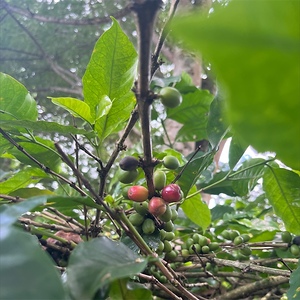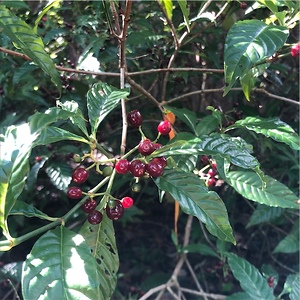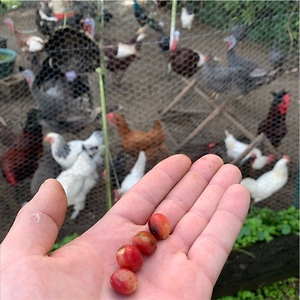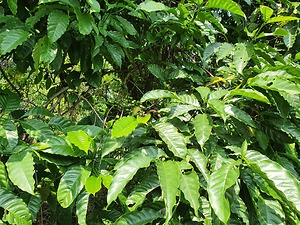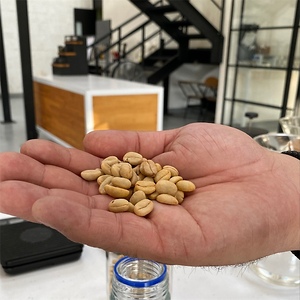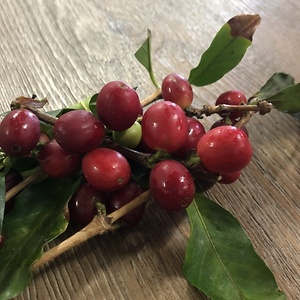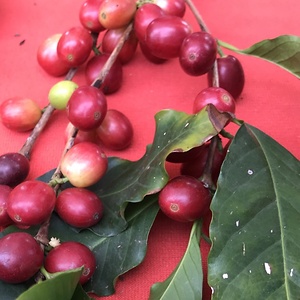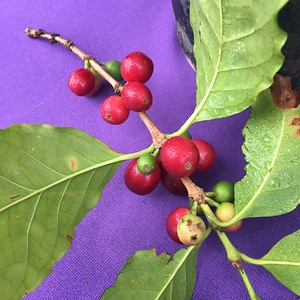

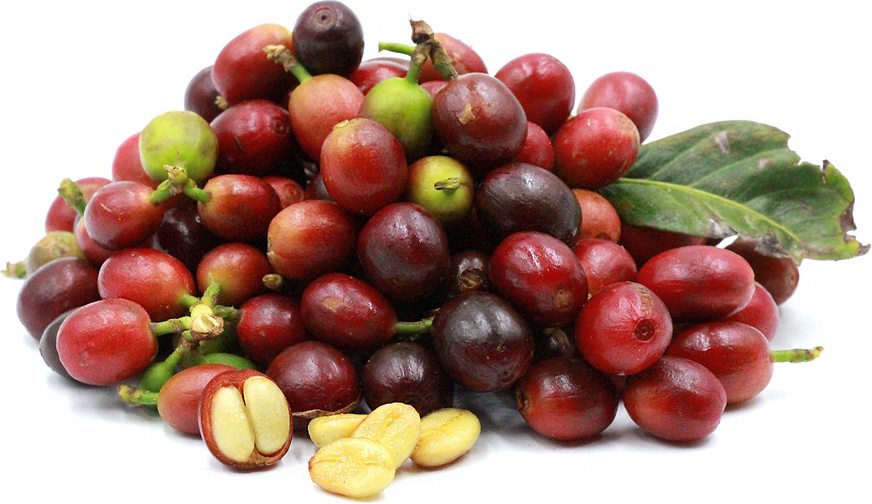
Coffee Berries
Estimated Inventory, lb : 0
Description/Taste
Coffee berries are small in size, averaging 1 to 2 centimeters in length, and have an oval to oblong shape with blunt, curved ends. The berries are about the size and shape of a standard commercial grape, sometimes smaller, and grow in clusters along the branches. The fruit's skin, also known as the exocarp, is somewhat tough, thick, and leathery, with a smooth, taut, and glossy appearance. The skin also ripens from green to shades of dark red, golden yellow, to purple-red, depending on the variety. Underneath the surface, the flesh, or the mesocarp, is thin, aqueous, and jelly-like with a succulent, soft consistency. Most Coffee berries contain only small amounts of flesh, and between the flesh and the seeds is a slimy, mucilaginous layer known as the parenchyma. There are typically two seeds in every fruit, and the seeds are flat on one side and curved on the other, meeting with the flat sides in the center. When young, coffee berry seeds are green and ripen to a yellow or red hue. When raw, the seeds are dense, very hard, and must be roasted to create a brittle, more manageable nature. A small percentage of Coffee berries will only have one seed, and these fruits are known as Peaberries. Coffee berry seeds also have a parchment-like protective coating known as the silverskin that is removed when the seeds are being processed. Coffee berries are typically harvested by color. The berries are also tested for ripeness by being squeezed. If the seeds pop out, then the fruit is ripe. The fruit's skin has a bitter taste, and the flesh is sweet, refreshing, vegetal, and fruity with notes of cherries, watermelon, hibiscus, and apricot.
Seasons/Availability
Coffee berries are available between September and March when grown north of the Equator. South of the Equator, the fruits are harvested from April through May.
Current Facts
Coffee berries are a part of the Coffea genus and are the small fruits of the Coffea plant belonging to the Rubiaceae family. Coffea trees thrive in tropical regions worldwide and can grow 10 meters in height, often pruned and kept smaller to produce more concentrated fruits. Coffee berries are also known as Coffee cherries and Coffee fruits, which take around 7 to 8 months to ripen, harvested once per year. Coffee berries are famously known for producing Coffee beans, also known as seeds, that are used to make the famous hot beverage. Coffee beans are a cash crop, and historically, the seeds were extracted from the fruits, discarding the peel and thin flesh. Growers began noticing the waste in coffee production, and the skin and flesh were researched and found to have beneficial nutritional properties, leading select visionaries to promote the fruits as a whole. In the modern day, Coffee berries are used in supplements, powders, juices, and extracts to flavor beverages and culinary dishes. The fruits are deemed ripe by color, and two main harvesting methods exist. The first method strips the fruits from the branches, while the second method requires only the ripe fruits to be picked from the tree. Once the fruits are picked, they undergo several treatments to remove the flesh, leaving the green coffee seeds. These seeds are roasted and ground into a powder to create coffee. There are two main commercial species of Coffee plants. Coffea arabica, known as Arabica coffee, is the most popular species for production and accounts for 60 to 70 percent of the coffee grown worldwide. This species is favored for its mild, smooth taste. Coffea canephora, or Robusta coffee, accounts for 30 to 40 percent of commercially grown coffee and is typically used in blends since it tastes more bitter.
Nutritional Value
Coffee berries are a source of fiber to regulate the digestive tract, potassium to balance fluid levels within the body, and magnesium to regulate optimal nerve functioning. The berries also provide vitamin C to strengthen the immune system, calcium to build strong bones and teeth, phosphorus to repair tissues, and other nutrients, including iron, copper, riboflavin, and vitamin A. Coffee berries are known for their antioxidants to protect the cells against the damage caused by free radicals and reduce inflammation, and the seeds in the berries contain caffeine, a natural stimulant. The berries are also recognized in natural medicines for their nutritional properties and are added to supplements, capsules, extracts, and beauty products.
Applications
Coffee berries are universally cultivated for their seeds, which are roasted and processed to produce coffee. The fruit's skin and thin flesh are also used on a smaller scale to create juices, teas, and powders for baking. Coffee berry flesh can be pressed, juiced, and combined with other fruit juices or water as a sweet beverage, or it can be incorporated into cocktails. The flesh and skin can also be simmered into jams and jellies or infused into syrups. In addition to using the raw flesh, Coffee berries can be dried and ground into a powder. This powder is used in drinks, used as a partial substitute for traditional flour in recipes, or mixed into dips, barbeque sauce, and ketchup. Coffee berry powder can also be baked into cookies, cupcakes, pies, and bread, blended with other spices into a pre-mixed seasoning, or added into smoothies. When dried, Coffee berry peels are sometimes steeped into a tea known as Cascara and have caffeine levels similar to black tea. There is some debate surrounding the dried peel tea, so it is recommended to conduct additional research and speak with a medical professional before consuming any unfamiliar products. Coffee berries can also be made into an extract and used as a flavoring or as a nutritional booster. Beyond the fruits, the roasted seeds can be ground and used to flavor ice cream, baked goods, and chocolates. One of the most expensive coffees in the world is created from Coffee seeds that were ingested and excreted by the Asian Palm Civet cat. It is said the cat only eats the ripest berries, meaning the seeds excreted have quality flavors, roasted into a coffee known as Kopi Luwak. Coffee berries are highly perishable and should be immediately consumed for the best quality and taste.
Ethnic/Cultural Info
The first documented coffeehouse opened in Constantinople, now modern-day Istanbul, sometime in the 15th century. Coffeehouses were initially known as Kiva Han or Gahveh Khaneh in Turkey, and the hot beverage was considered a staple among Arabian Peninsula residents. Gathering at coffeehouses became an essential part of society and overall social culture. It was customary for people to discuss various current news topics with friends and acquaintances, and performers would play live music and entertain the crowds. Some coffeehouse visitors would also play chess and use the space as a place to stay in the know. Coffeehouses quickly became known as "Schools of the Wise," and sharing knowledge around a cup of hot coffee became the lifeblood of the Turkish community. Later in history, coffeehouses in 17th-century London were nicknamed "Penny Universities," as cups of coffee cost 1 cent. London residents also engaged in thought-provoking conversations over hot beverages, and famous intellectuals, including Rousseau and Voltaire, were known to frequent coffeehouses.
Geography/History
Species within the Coffea genus are believed by experts to be native to the Ethiopian Plateau, a highland region that spans most of the present-day country. The exact origins of the Coffee plant are unknown, but one of the most well-known stories traces the discovery of the plant to a goat herder in Ethiopia around 850 CE. Legend has it a goat herder named Kaldi noticed his flock was consuming red berries from an unknown tree. Not long after eating the unfamiliar fruits, the goats began exhibiting lively actions and were described as dancing. Kaldi later presented the fruits to a local monastery, where monks began studying the fruits. It was discovered that the fruits would help the monks stay awake for extended periods. The Oromo people in Ethiopia also believed that Coffee plants sprout from the tears of a God and interweave the plant's creation into a legend surrounding the god Waqa. Despite these various stories being classified as folklore and the actual origins unknown, rumors of the stimulant-filled fruit spread into the Arabian Peninsula. Coffee berries were first documented by a Persian physician sometime around the 10th century, and cultivation of the plants for their seeds was completed by growers in Yemen by the 15th century. Coffee plant production also spread to Egypt, Syria, Persia, and Turkey in the 16th century, and in the 17th century, the plants were introduced to Europe. When coffee was initially presented in Europe, it was met with some backlash, with groups claiming the drink was the "bitter invention of Satan." Over time, the conflict became so heated in Italy that Pope Clement VIII was asked for his opinion. The Pope tried the drink and gave it official approval. Coffee plants reached the New World sometime around the early 18th century and were planted in several locations throughout the Americas and the Caribbean. Today, Coffee plants are commercially grown in a region of the world nicknamed the “coffee belt” along both sides of the equator in Africa, the Americas, and Asia, with the majority of coffee export coming from Brazil, Vietnam, Colombia, Indonesia, and Ethiopia. Coffee plants are also being cultivated on a small scale through growers in tropical to subtropical regions worldwide, including San Diego.
Recipe Ideas
Recipes that include Coffee Berries. One
| Twin Engine Coffee |
|
Coffee Berry Tea |
Podcast



